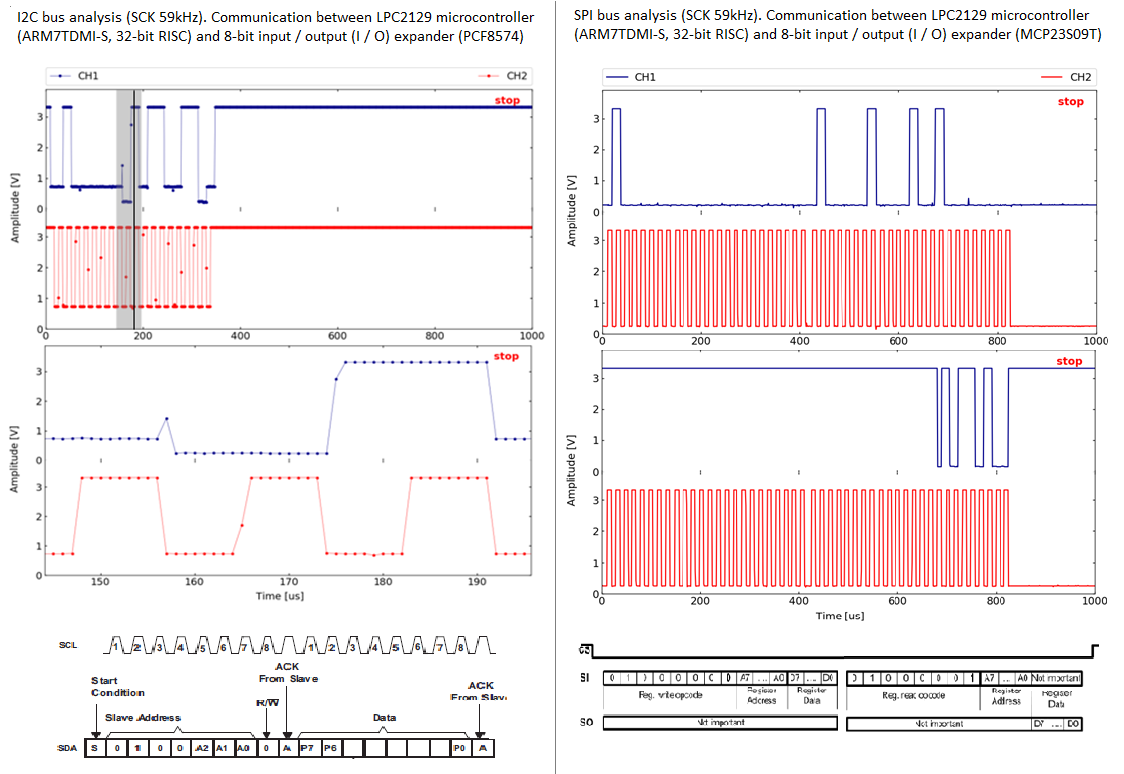MiniOscilloscope
Design and implementation of a miniature oscilloscope module with a usb interface. The main use of the module is monitoring the signals SPI and I2C interfaces. The repository is a patchwork of files that makes entire project. More accurate information about the project can be found in the ./docs/ (unfortunately Polish language)
Project of the MiniOscilloscope includes:
- PCB design and assembly,
- program for XMEAGA 32A4-AU microcontroller written in C,
- GUI run on PC written in Python,
- system tests.
Table of Contents
Requirements
Acquisition parameters:
- time resolution of at least 15 samples per clock cycle (SPI / I2C)
- 8bit voltage resolution
- input voltage range 0 - 3.3V
- two channels
- trigger signal input
- trigger mode: normal
Parameters of the printed circuit:
- minimum sizes
- two-layer
- elements on one side of PCB
- possibility of manual PCB assembly
Electrical parameters:
- power supply from USB
- surge protection
User application:
- displays observed signals in real time
- allows you to manipulate presented graph
- allows you to stop/start acquisition Other:
- minimal construction cost
- data transmission to PC using the USB interface
- test signal output
System architecture
MiniOscilloscope module
Schematic
BOM
PCB design
The PCB was designed in accordance with the assumptions set in Requirements paragraph. Parameters of the printed circuit:
- dimensions: 22 x 32 mm,
- two-layer circuit,
- min track width: 8 mil
- min space between tracks: 6 mil
- min hole: 0.45 mm
- min border: 11 mil
- descriptions: TOP layer
Microcontroller program
Complete source code in ./source/Xmega/
int main(void)
{
sysclk_init();
pmic_init();
adc_init();
dma_init();
evsys_init();
tc_init();
ioport_init();
ioport_set_pin_dir(IO_TRIGGER, IOPORT_DIR_INPUT);
ioport_set_pin_mode(IO_TRIGGER, IOPORT_MODE_PULLUP);
ioport_set_pin_dir(IO_CTRL_LED, IOPORT_DIR_OUTPUT);
cpu_irq_enable();
adc_enable(&ADCA);
pwm_enable();
udc_start();
while (1)
{
while(!udi_cdc_getc());
while (0 == ioport_get_pin_level(IO_TRIGGER));
while (1 == ioport_get_pin_level(IO_TRIGGER));
dma_channel_enable(DMA_CHANNEL_0);
dma_channel_enable(DMA_CHANNEL_1);
if (udi_cdc_is_tx_ready())
{
while(dma_channel_is_busy(DMA_CHANNEL_1));
udi_cdc_write_buf(&buffer_samples, RAM_BUFFER_SIZE_2000);
ioport_toggle_pin_level(IO_CTRL_LED);
}
}
}User application
Complete source code in ./source/Gui/
from Gui import *
import serial
SAMPLES_NR=1000
CHANNEL_NR=2
serial_port = serial.Serial(port = 'COM3', write_timeout=0.1, inter_byte_timeout=0.1)
serial_port.flushInput()
RTS= bytearray(b'\xff')
gui=GUI(CHANNEL_NR,SAMPLES_NR)
paused = False
while True:
key = gui.get_key()
if key == ' ':
paused = not paused
gui.toggle_state()
elif key == 'escape':
break
if not paused:
try:
serial_port.flushInput()
serial_port.write(RTS)
for channel in range(CHANNEL_NR):
buffer = serial_port.read(SAMPLES_NR)
gui.set_y(channel, buffer)
except:
pass
gui.plot()
gui.pause()





